Metabolism of Terephthalic Acid by a Novel Bacterial Consortium Produces Valuable By-Products
Abstract
1. Introduction
2. Materials and Methods
2.1. Liquid Media Preparation, Inoculation, and Collection
2.2. Cell Physiology Assays and Measurements
2.3. 16S rRNA Sequencing
2.4. LC-MS/MS Analysis
2.5. HPLC Analysis
2.6. RT-qPCR Analysis
3. Results
3.1. Bacterial Consortium Physiology
3.2. Bacterial Consortium Composition
3.3. TPA Metabolism Is Mediated by the Benzoate Degradation Pathway to Facilitate Oxidative Phosphorylation
3.4. Metabolomic Profiling Reveals the TPA-Induced Activation of the Benzoate Degradation Pathway
3.5. Expression of TPA Degradation Pathway Genes in P. fungorum
4. Discussion
5. Conclusions
Supplementary Materials
Author Contributions
Funding
Institutional Review Board Statement
Informed Consent Statement
Data Availability Statement
Conflicts of Interest
References
- Rani, M.; Shim, W.J.; Han, G.M.; Jang, M.; Al-Odaini, N.A.; Song, Y.K.; Hong, S.H. Qualitative Analysis of Additives in Plastic Marine Debris and Its New Products. Arch. Environ. Contam. Toxicol. 2015, 69, 352–366. [Google Scholar] [CrossRef]
- Sigler, M. The Effects of Plastic Pollution on Aquatic Wildlife: Current Situations and Future Solutions. Water Air Soil Pollut. 2014, 225, 2184. [Google Scholar] [CrossRef]
- Lear, G.; Kingsbury, J.M.; Franchini, S.; Gambarini, V.; Maday, S.D.M.; Wallbank, J.A.; Weaver, L.; Pantos, O. Plastics and the Microbiome: Impacts and Solutions. Environ. Microbiome 2021, 16, 2. [Google Scholar] [CrossRef]
- Tang, Y.; Liu, Y.; Chen, Y.; Zhang, W.; Zhao, J.; He, S.; Yang, C.; Zhang, T.; Tang, C.; Zhang, C.; et al. A Review: Research Progress on Microplastic Pollutants in Aquatic Environments. Sci. Total Environ. 2021, 766, 142572. [Google Scholar] [CrossRef]
- Bermúdez, J.R.; Swarzenski, P.W. A Microplastic Size Classification Scheme Aligned with Universal Plankton Survey Methods. MethodsX 2021, 8, 101516. [Google Scholar] [CrossRef] [PubMed]
- Padha, S.; Kumar, R.; Dhar, A.; Sharma, P. Microplastic Pollution in Mountain Terrains and Foothills: A Review on Source, Extraction, and Distribution of Microplastics in Remote Areas. Environ. Res. 2022, 207, 112232. [Google Scholar] [CrossRef] [PubMed]
- Vethaak, A.D.; Legler, J. Microplastics and Human Health. Science 2021, 371, 672–674. [Google Scholar] [CrossRef]
- Amran, N.H.; Zaid, S.S.M.; Mokhtar, M.H.; Manaf, L.A.; Othman, S. Exposure to Microplastics during Early Developmental Stage: Review of Current Evidence. Toxics 2022, 10, 597. [Google Scholar] [CrossRef]
- Zheng, H.; Wang, J.; Wei, X.; Chang, L.; Liu, S. Proinflammatory Properties and Lipid Disturbance of Polystyrene Microplastics in the Livers of Mice with Acute Colitis. Sci. Total Environ. 2021, 750, 143085. [Google Scholar] [CrossRef] [PubMed]
- Luo, T.; Wang, D.; Zhao, Y.; Li, X.; Yang, G.; Jin, Y. Polystyrene Microplastics Exacerbate Experimental Colitis in Mice Tightly Associated with the Occurrence of Hepatic Inflammation. Sci. Total Environ. 2022, 844, 156884. [Google Scholar] [CrossRef]
- Bennett, E.M.; Alexandridis, P. Informing the Public and Educating Students on Plastic Recycling. Recycling 2021, 6, 69. [Google Scholar] [CrossRef]
- Di, J.; Reck, B.K.; Miatto, A.; Graedel, T.E. United States Plastics: Large Flows, Short Lifetimes, and Negligible Recycling. Resour. Conserv. Recycl. 2021, 167, 105440. [Google Scholar] [CrossRef]
- Rahimi, A.; García, J.M. Chemical Recycling of Waste Plastics for New Materials Production. Nat. Rev. Chem. 2017, 1, 0046. [Google Scholar] [CrossRef]
- Wang, W.; Wang, L.; Shao, Z. Polycyclic Aromatic Hydrocarbon (PAH) Degradation Pathways of the Obligate Marine PAH Degrader Cycloclasticus sp. Strain P1. Appl. Environ. Microbiol. 2018, 84, e01261-18. [Google Scholar] [CrossRef]
- Čolnik, M.; Pečar, D.; Knez, Ž.; Goršek, A.; Škerget, M. Kinetics Study of Hydrothermal Degradation of PET Waste into Useful Products. Processes 2022, 10, 24. [Google Scholar] [CrossRef]
- Solis, M.; Silveira, S. Technologies for Chemical Recycling of Household Plastics—A Technical Review and TRL Assessment. Waste Manag. 2020, 105, 128–138. [Google Scholar] [CrossRef]
- Qadeer, A.; Anis, M.; Warner, G.R.; Potts, C.; Giovanoulis, G.; Nasr, S.; Archundia, D.; Zhang, Q.; Ajmal, Z.; Tweedale, A.C.; et al. Global Environmental and Toxicological Data of Emerging Plasticizers: Current Knowledge, Regrettable Substitution Dilemma, Green Solution and Future Perspectives. Green Chem. 2024, 26, 5635–5683. [Google Scholar] [CrossRef]
- Vega-Herrera, A.; Savva, K.; Lacoma, P.; Santos, L.H.M.L.M.; Hernández, A.; Marmelo, I.; Marques, A.; Llorca, M.; Farré, M. Bioaccumulation and Dietary Bioaccessibility of Microplastics Composition and Cocontaminants in Mediterranean Mussels. Chemosphere 2024, 363, 142934. [Google Scholar] [CrossRef]
- Fotopoulou, K.N.; Karapanagioti, H.K. Degradation of Various Plastics in the Environment. In Hazardous Chemicals Associated with Plastics in the Marine Environment; Takada, H., Karapanagioti, H.K., Eds.; Springer International Publishing: Cham, Switzerland, 2019; pp. 71–92. ISBN 978-3-319-95568-1. [Google Scholar]
- Gupta, R.K.; Pipliya, S.; Karunanithi, S.; Eswaran U, G.M.; Kumar, S.; Mandliya, S.; Srivastav, P.P.; Suthar, T.; Shaikh, A.M.; Harsányi, E. Migration of Chemical Compounds from Packaging Materials into Packaged Foods: Interaction, Mechanism, Assessment, and Regulations. Foods 2024, 13, 3125. [Google Scholar] [CrossRef]
- Liu, F.; Wang, T.; Liu, X.; Xu, N.; Pan, X. Efficient Biodegradation and Upcycling of Polyethylene Terephthalate Mediated by Cell-Factories. Front. Microbiol. 2025, 16, 1599470. [Google Scholar] [CrossRef]
- Kotova, I.B.; Taktarova, Y.V.; Tsavkelova, E.A.; Egorova, M.A.; Bubnov, I.A.; Malakhova, D.V.; Shirinkina, L.I.; Sokolova, T.G.; Bonch-Osmolovskaya, E.A. Microbial Degradation of Plastics and Approaches to Make It More Efficient. Microbiology 2021, 90, 671–701. [Google Scholar] [CrossRef]
- Bhardwaj, H.; Gupta, R.; Tiwari, A. Communities of Microbial Enzymes Associated with Biodegradation of Plastics. J. Polym. Environ. 2013, 21, 575–579. [Google Scholar] [CrossRef]
- Ghosh, S.K.; Pal, S.; Ray, S. Study of Microbes Having Potentiality for Biodegradation of Plastics. Environ. Sci. Pollut. Res. 2013, 20, 4339–4355. [Google Scholar] [CrossRef]
- Urbanek, A.K.; Rymowicz, W.; Mirończuk, A.M. Degradation of Plastics and Plastic-Degrading Bacteria in Cold Marine Habitats. Appl. Microbiol. Biotechnol. 2018, 102, 7669–7678. [Google Scholar] [CrossRef]
- Bergeson, A.R.; Silvera, A.J.; Alper, H.S. Bottlenecks in Biobased Approaches to Plastic Degradation. Nat. Commun. 2024, 15, 4715. [Google Scholar] [CrossRef]
- Zeenat; Elahi, A.; Bukhari, D.A.; Shamim, S.; Rehman, A. Plastics Degradation by Microbes: A Sustainable Approach. J. King Saud Univ. Sci. 2021, 33, 101538. [Google Scholar] [CrossRef]
- Fuchs, G.; Boll, M.; Heider, J. Microbial Degradation of Aromatic Compounds—From One Strategy to Four. Nat. Rev. Microbiol. 2011, 9, 803–816. [Google Scholar] [CrossRef]
- Li, J.; Ou, Y.; Wang, L.; Zheng, Y.; Xu, W.; Peng, J.; Zhang, X.; Cao, Z.; Ye, J. Responses of a Polycyclic Aromatic Hydrocarbon-Degrading Bacterium, Paraburkholderia Fungorum JT-M8, to Cd (II) under P-Limited Oligotrophic Conditions. J. Hazard. Mater. 2024, 465, 133123. [Google Scholar] [CrossRef]
- Anderson, S.; Appanna, V.D.; Huang, J.; Viswanatha, T. A Novel Role for Calcite in Calcium Homeostasis. FEBS Lett. 1992, 308, 94–96. [Google Scholar] [CrossRef]
- Kopp, J.; Slouka, C.; Ulonska, S.; Kager, J.; Fricke, J.; Spadiut, O.; Herwig, C. Impact of Glycerol as Carbon Source onto Specific Sugar and Inducer Uptake Rates and Inclusion Body Productivity in E. coli BL21(DE3). Bioengineering 2017, 5, 1. [Google Scholar] [CrossRef]
- Poblete-Castro, I.; Wittmann, C.; Nikel, P.I. Biochemistry, Genetics and Biotechnology of Glycerol Utilization in Pseudomonas Species. Microb. Biotechnol. 2019, 13, 32–53. [Google Scholar] [CrossRef]
- Adnan, A.; Nair, G.R.; Lay, M.C.; Swan, J.E.; Umar, R. Glycerol as a Cheaper Carbon Source in Bacterial Cellulose (BC) Production by Gluconacetobacter Xylinus DSM46604 in Batch Fermentation System. Malays. J. Anal. Sci. 2015, 19, 1131–1136. [Google Scholar]
- Zhang, X.; Qin, J. Degradation of Aliphatic and Aromatic Hydrocarbon Mixture by a Rhodococcus sp. Water Sci. Technol. 2024, 91, 12–20. [Google Scholar] [CrossRef]
- Shahidi Rizi, M.S.; Emtiazi, G.; Akhavan Sepahy, A. Biodegradation of Aliphatic and Aromatic Hydrocarbons by Bacteria Isolated from Bahregan Area. Lett. Appl. Microbiol. 2024, 77, ovae040. [Google Scholar] [CrossRef]
- Alhasawi, A.A.; Thomas, S.C.; Tharmalingam, S.; Legendre, F.; Appanna, V.D. Isocitrate Lyase and Succinate Semialdehyde Dehydrogenase Mediate the Synthesis of α-Ketoglutarate in Pseudomonas Fluorescens. Front. Microbiol. 2019, 10, 1929. [Google Scholar] [CrossRef]
- MacLean, A.; Legendre, F.; Tharmalingam, S.; Appanna, V.D. Phosphate Stress Triggers the Conversion of Glycerol into L-Carnitine in Pseudomonas fluorescens. Microbiol. Res. 2021, 253, 126865. [Google Scholar] [CrossRef]
- Bradford, M.M. A Rapid and Sensitive Method for the Quantitation of Microgram Quantities of Protein Utilizing the Principle of Protein-Dye Binding. Anal. Biochem. 1976, 72, 248–254. [Google Scholar] [CrossRef]
- Jameus, A.; Dougherty, J.; Narendrula, R.; Levert, D.; Valiquette, M.; Pirkkanen, J.; Lalonde, C.; Bonin, P.; Gagnon, J.D.; Appanna, V.D.; et al. Acute Impacts of Ionizing Radiation Exposure on the Gastrointestinal Tract and Gut Microbiome in Mice. Int. J. Mol. Sci. 2024, 25, 3339. [Google Scholar] [CrossRef]
- Wang, Q.; Garrity, G.M.; Tiedje, J.M.; Cole, J.R. Naïve Bayesian Classifier for Rapid Assignment of rRNA Sequences into the New Bacterial Taxonomy. Appl. Environ. Microbiol. 2007, 73, 5261–5267. [Google Scholar] [CrossRef]
- Pang, Z.; Lu, Y.; Zhou, G.; Hui, F.; Xu, L.; Viau, C.; Spigelman, A.F.; MacDonald, P.E.; Wishart, D.S.; Li, S.; et al. MetaboAnalyst 6.0: Towards a Unified Platform for Metabolomics Data Processing, Analysis and Interpretation. Nucleic Acids Res. 2024, 52, W398–W406. [Google Scholar] [CrossRef]
- Liu, G.; Lee, D.P.; Schmidt, E.; Prasad, G. Pathway Analysis of Global Metabolomic Profiles Identified Enrichment of Caffeine, Energy, and Arginine Metabolism in Smokers but Not Moist Snuff Consumers. Bioinform. Biol. Insights 2019, 13, 1177932219882961. [Google Scholar] [CrossRef]
- Alhasawi, A.; Auger, C.; Appanna, V.P.; Chahma, M.; Appanna, V.D. Zinc Toxicity and ATP Production in Pseudomonas Fluorescens. J. Appl. Microbiol. 2014, 117, 65–73. [Google Scholar] [CrossRef]
- Legendre, F.; Tharmalingam, S.; Bley, A.M.; MacLean, A.; Appanna, V.D. Metabolic Adaptation and NADPH Homeostasis Evoked by a Sulfur-Deficient Environment in Pseudomonas Fluorescens. Antonie Van Leeuwenhoek 2020, 113, 605–616. [Google Scholar] [CrossRef]
- Livak, K.J.; Schmittgen, T.D. Analysis of Relative Gene Expression Data Using Real-Time Quantitative PCR and the 2−ΔΔCT Method. Methods 2001, 25, 402–408. [Google Scholar] [CrossRef]
- Boll, M.; Geiger, R.; Junghare, M.; Schink, B. Microbial Degradation of Phthalates: Biochemistry and Environmental Implications. Environ. Microbiol. Rep. 2020, 12, 3–15. [Google Scholar] [CrossRef]
- Reineke, W.; Schlömann, M. Microbial Degradation of Pollutants. In Environmental Microbiology; Reineke, W., Schlömann, M., Eds.; Springer: Berlin/Heidelberg, Germany, 2023; pp. 161–290. ISBN 978-3-662-66547-3. [Google Scholar]
- Schuler, J.; Hornung, U.; Dahmen, N.; Sauer, J. Lignin from Bark as a Resource for Aromatics Production by Hydrothermal Liquefaction. GCB Bioenergy 2018, 11, 218–229. [Google Scholar] [CrossRef]
- Ling, C.; Peabody, G.L.; Salvachúa, D.; Kim, Y.-M.; Kneucker, C.M.; Calvey, C.H.; Monninger, M.A.; Munoz, N.M.; Poirier, B.C.; Ramirez, K.J.; et al. Muconic Acid Production from Glucose and Xylose in Pseudomonas Putida via Evolution and Metabolic Engineering. Nat. Commun. 2022, 13, 4925. [Google Scholar] [CrossRef]
- Gao, J.; Jin, Z.; Pan, Z. Depolymerization of Poly(Trimethylene Terephthalate) in Hot Compressed Water at 240–320 °C. Polym. Degrad. Stab. 2012, 97, 1838–1843. [Google Scholar] [CrossRef]
- Yoshida, S.; Hiraga, K.; Takehana, T.; Taniguchi, I.; Yamaji, H.; Maeda, Y.; Toyohara, K.; Miyamoto, K.; Kimura, Y.; Oda, K. A Bacterium That Degrades and Assimilates Poly(Ethylene Terephthalate). Science 2016, 351, 1196–1199. [Google Scholar] [CrossRef]
- Madhaiyan, M.; Sriram, S.; Kiruba, N.; Saravanan, V.S. Genome-Based Reclassification of Paraburkholderia insulsa as a Later Heterotypic Synonym of Paraburkholderia fungorum and Proposal of Paraburkholderia terrae subsp. terrae subsp. nov. and Paraburkholderia terrae subsp. steynii subsp. nov. Curr. Microbiol. 2022, 79, 358. [Google Scholar] [CrossRef]
- Tan, K.Y.; Dutta, A.; Tan, T.K.; Hari, R.; Othman, R.Y.; Choo, S.W. Comprehensive Genome Analysis of a Pangolin-Associated Paraburkholderia Fungorum Provides New Insights into Its Secretion Systems and Virulence. PeerJ 2020, 8, e9733. [Google Scholar] [CrossRef]
- Wilhelm, R.C.; Murphy, S.J.L.; Feriancek, N.M.; Karasz, D.C.; DeRito, C.M.; Newman, J.D.; Buckley, D.H. Paraburkholderia madseniana sp. nov., a Phenolic Acid-Degrading Bacterium Isolated from Acidic Forest Soil. Int. J. Syst. Evol. Microbiol. 2020, 70, 2137–2146, Corrigendum in Int. J. Syst. Evol. Microbiol. 2020, 70, 6534–6538. [Google Scholar] [CrossRef]
- Magrì, D.; Veronesi, M.; Sánchez-Moreno, P.; Tolardo, V.; Bandiera, T.; Pompa, P.P.; Athanassiou, A.; Fragouli, D. PET Nanoplastics Interactions with Water Contaminants and Their Impact on Human Cells. Environ. Pollut. 2021, 271, 116262. [Google Scholar] [CrossRef] [PubMed]
- Rochman, C.M.; Hoh, E.; Hentschel, B.T.; Kaye, S. Long-Term Field Measurement of Sorption of Organic Contaminants to Five Types of Plastic Pellets: Implications for Plastic Marine Debris. Environ. Sci. Technol. 2013, 47, 1646–1654. [Google Scholar] [CrossRef]
- Dhaka, V.; Singh, S.; Anil, A.G.; Sunil Kumar Naik, T.S.; Garg, S.; Samuel, J.; Kumar, M.; Ramamurthy, P.C.; Singh, J. Occurrence, Toxicity and Remediation of Polyethylene Terephthalate Plastics. A Review. Env. Chem. Lett. 2022, 20, 1777–1800. [Google Scholar] [CrossRef] [PubMed]
- Sinha, V.; Patel, M.R.; Patel, J.V. Pet Waste Management by Chemical Recycling: A Review. J. Polym. Env. 2010, 18, 8–25. [Google Scholar] [CrossRef]
- Soong, Y.-H.V.; Sobkowicz, M.J.; Xie, D. Recent Advances in Biological Recycling of Polyethylene Terephthalate (PET) Plastic Wastes. Bioengineering 2022, 9, 98. [Google Scholar] [CrossRef]
- Willetts, A. Bacterial Metabolism of Ethylene Glycol. Biochim. Biophys. Acta (BBA)–Gen. Subj. 1981, 677, 194–199. [Google Scholar] [CrossRef]
- Mückschel, B.; Simon, O.; Klebensberger, J.; Graf, N.; Rosche, B.; Altenbuchner, J.; Pfannstiel, J.; Huber, A.; Hauer, B. Ethylene Glycol Metabolism by Pseudomonas Putida. Appl. Environ. Microbiol. 2012, 78, 8531–8539. [Google Scholar] [CrossRef]
- Hachisuka, S.; Chong, J.F.; Fujiwara, T.; Takayama, A.; Kawakami, Y.; Yoshida, S. Ethylene Glycol Metabolism in the Poly(Ethylene Terephthalate)-Degrading Bacterium Ideonella Sakaiensis. Appl. Microbiol. Biotechnol. 2022, 106, 7867–7878. [Google Scholar] [CrossRef]
- Otto, M.; Wynands, B.; Marienhagen, J.; Blank, L.M.; Wierckx, N. Benzoate Synthesis from Glucose or Glycerol Using Engineered Pseudomonas Taiwanensis. Biotechnol. J. 2020, 15, 2000211. [Google Scholar] [CrossRef] [PubMed]
- Grove, A. MarR Family Transcription Factors. Curr. Biol. 2013, 23, R142–R143. [Google Scholar] [CrossRef]
- Grove, A. Regulation of Metabolic Pathways by MarR Family Transcription Factors. Comput. Struct. Biotechnol. J. 2017, 15, 366–371. [Google Scholar] [CrossRef] [PubMed]
- Roux, M.; Varrone, C. Assessing the Economic Viability of the Plastic Biorefinery Concept and Its Contribution to a More Circular Plastic Sector. Polymers 2021, 13, 3883. [Google Scholar] [CrossRef] [PubMed]
- Tamoor, M.; Samak, N.A.; Jia, Y.; Mushtaq, M.U.; Sher, H.; Bibi, M.; Xing, J. Potential Use of Microbial Enzymes for the Conversion of Plastic Waste Into Value-Added Products: A Viable Solution. Front. Microbiol. 2021, 12, 777727. [Google Scholar] [CrossRef]
- Moshood, T.D.; Nawanir, G.; Mahmud, F. Sustainability of Biodegradable Plastics: A Review on Social, Economic, and Environmental Factors. Crit. Rev. Biotechnol. 2022, 42, 892–912. [Google Scholar] [CrossRef]
- Saiz-Poseu, J.; Mancebo-Aracil, J.; Nador, F.; Busqué, F.; Ruiz-Molina, D. The Chemistry behind Catechol-Based Adhesion. Angew. Chem. Int. Ed. 2019, 58, 696–714. [Google Scholar] [CrossRef]
- Sedó, J.; Saiz-Poseu, J.; Busqué, F.; Ruiz-Molina, D. Catechol-Based Biomimetic Functional Materials. Adv. Mater. 2013, 25, 653–701. [Google Scholar] [CrossRef]
- Tang, Z.; Lin, X.; Yu, M.; Yang, J.; Li, S.; Mondal, A.K.; Wu, H. A Review of Cellulose-Based Catechol-Containing Functional Materials for Advanced Applications. Int. J. Biol. Macromol. 2024, 266, 131243. [Google Scholar] [CrossRef]
- Choi, S.; Lee, H.-N.; Park, E.; Lee, S.-J.; Kim, E.-S. Recent Advances in Microbial Production of Cis,Cis-Muconic Acid. Biomolecules 2020, 10, 1238. [Google Scholar] [CrossRef]
- Vardon, D.R.; Rorrer, N.A.; Salvachúa, D.; Settle, A.E.; Johnson, C.W.; Menart, M.J.; Cleveland, N.S.; Ciesielski, P.N.; Steirer, K.X.; Dorgan, J.R.; et al. Cis,Cis-Muconic Acid: Separation and Catalysis to Bio-Adipic Acid for Nylon-6,6 Polymerization. Green Chem. 2016, 18, 3397–3413. [Google Scholar] [CrossRef]
- Shen, L.; Worrell, E. Chapter 31–Plastic Recycling. In Handbook of Recycling, 2nd ed.; Meskers, C., Worrell, E., Reuter, M.A., Eds.; Elsevier: Amsterdam, The Netherlands, 2024; pp. 497–510. ISBN 978-0-323-85514-3. [Google Scholar]
- d’Ambrières, W. Plastics Recycling Worldwide: Current Overview and Desirable Changes. Field Actions Sci. Rep. J. Field Actions 2019, 19, 12–21. [Google Scholar]
- Kahlert, S.; Bening, C.R. Why Pledges Alone Will Not Get Plastics Recycled: Comparing Recyclate Production and Anticipated Demand. Resour. Conserv. Recycl. 2022, 181, 106279. [Google Scholar] [CrossRef]
- Maity, W.; Maity, S.; Bera, S.; Roy, A. Emerging Roles of PETase and MHETase in the Biodegradation of Plastic Wastes. Appl. Biochem. Biotechnol. 2021, 193, 2699–2716. [Google Scholar] [CrossRef]
- Pinto, A.V.; Ferreira, P.; Neves, R.P.P.; Fernandes, P.A.; Ramos, M.J.; Magalhães, A.L. Reaction Mechanism of MHETase, a PET Degrading Enzyme. ACS Catal. 2021, 11, 10416–10428. [Google Scholar] [CrossRef]
- Yoshida, S.; Hiraga, K.; Taniguchi, I.; Oda, K. Ideonella sakaiensis, PETase, and MHETase: From Identification of Microbial PET Degradation to Enzyme Characterization. In Methods in Enzymology; Weber, G., Bornscheuer, U.T., Wei, R., Eds.; Enzymatic Plastic Degradation; Academic Press: Amsterdam, The Netherlands, 2021; Volume 648, pp. 187–205. [Google Scholar]
- Moscoso, F.; Teijiz, I.; Sanromán, M.A.; Deive, F.J. On the Suitability of a Bacterial Consortium To Implement a Continuous PAHs Biodegradation Process in a Stirred Tank Bioreactor. Ind. Eng. Chem. Res. 2012, 51, 15895–15900. [Google Scholar] [CrossRef]
- Ferreira, R.M.; Ribeiro, B.D.; Stapelfeldt, D.M.A.; do Nascimento, R.P.; Moreira, M.d.F.R. Oil Biodegradation Studies with an Immobilized Bacterial Consortium in Plant Biomass for the Construction of Bench-Scale Bioreactor. Clean. Chem. Eng. 2023, 6, 100107. [Google Scholar] [CrossRef]
- Patowary, K.; Patowary, R.; Kalita, M.C.; Deka, S. Development of an Efficient Bacterial Consortium for the Potential Remediation of Hydrocarbons from Contaminated Sites. Front. Microbiol. 2016, 7, 1092. [Google Scholar] [CrossRef]
- Sathishkumar, M.; Binupriya, A.R.; Baik, S.-H.; Yun, S.-E. Biodegradation of Crude Oil by Individual Bacterial Strains and a Mixed Bacterial Consortium Isolated from Hydrocarbon Contaminated Areas. CLEAN–Soil Air Water 2008, 36, 92–96. [Google Scholar] [CrossRef]
- La Mantia, F.P. Recycled Plastics: Additives and Their Effects on Properties. In Plastics Additives: An A-Z Reference; Pritchard, G., Ed.; Springer: Dordrecht, The Netherlands, 1998; pp. 535–543. ISBN 978-94-011-5862-6. [Google Scholar]
- Wu, H.; Mehrabi, H.; Karagiannidis, P.; Naveed, N. Additive Manufacturing of Recycled Plastics: Strategies towards a More Sustainable Future. J. Clean. Prod. 2022, 335, 130236. [Google Scholar] [CrossRef]
- Nielsen, A.T.; Tolker-Nielsen, T.; Barken, K.B.; Molin, S. Role of Commensal Relationships on the Spatial Structure of a Surface-Attached Microbial Consortium. Environ. Microbiol. 2000, 2, 59–68. [Google Scholar] [CrossRef]
- Xu, C.; Yu, H. Insights into Constructing a Stable and Efficient Microbial Consortium. Chin. J. Chem. Eng. 2021, 30, 112–120. [Google Scholar] [CrossRef]
- Kanehisa, M.; Goto, S. KEGG: Kyoto Encyclopedia of Genes and Genomes. Nucleic Acids Res. 2000, 28, 27–30. [Google Scholar] [CrossRef] [PubMed]
- Kanehisa, M.; Goto, S.; Kawashima, S.; Nakaya, A. The KEGG Databases at GenomeNet. Nucleic Acids Res. 2002, 30, 42–46. [Google Scholar] [CrossRef] [PubMed]


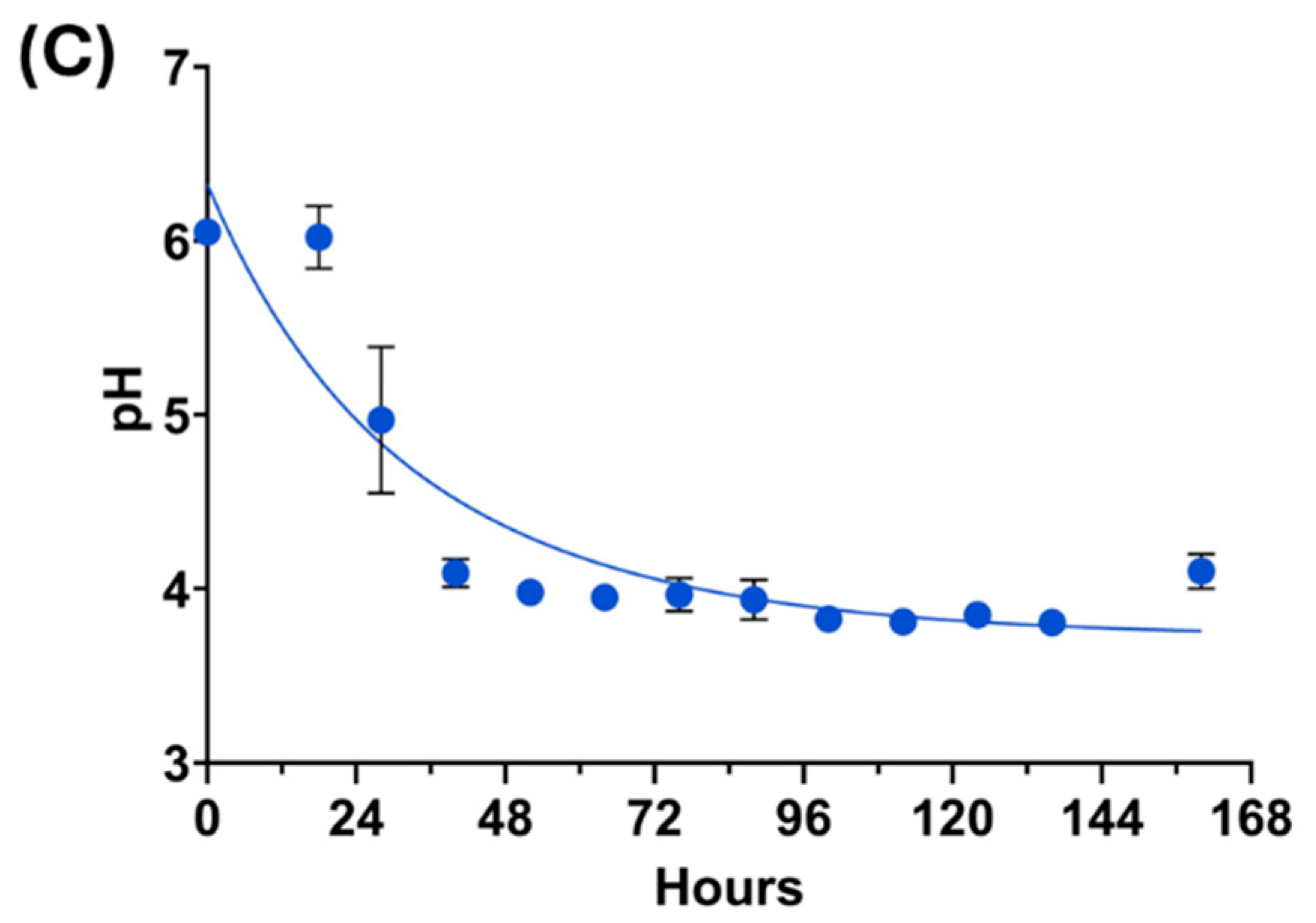

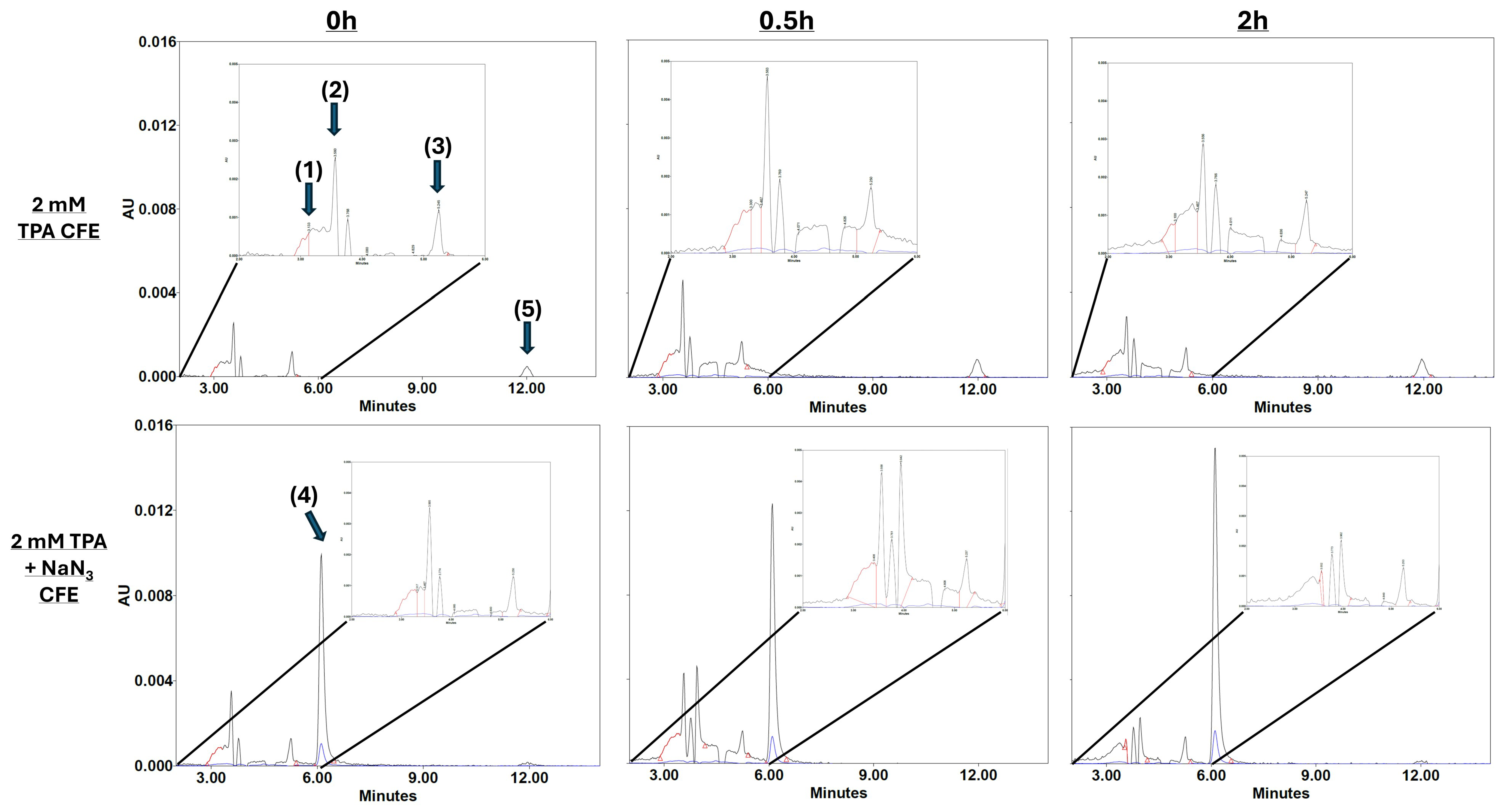
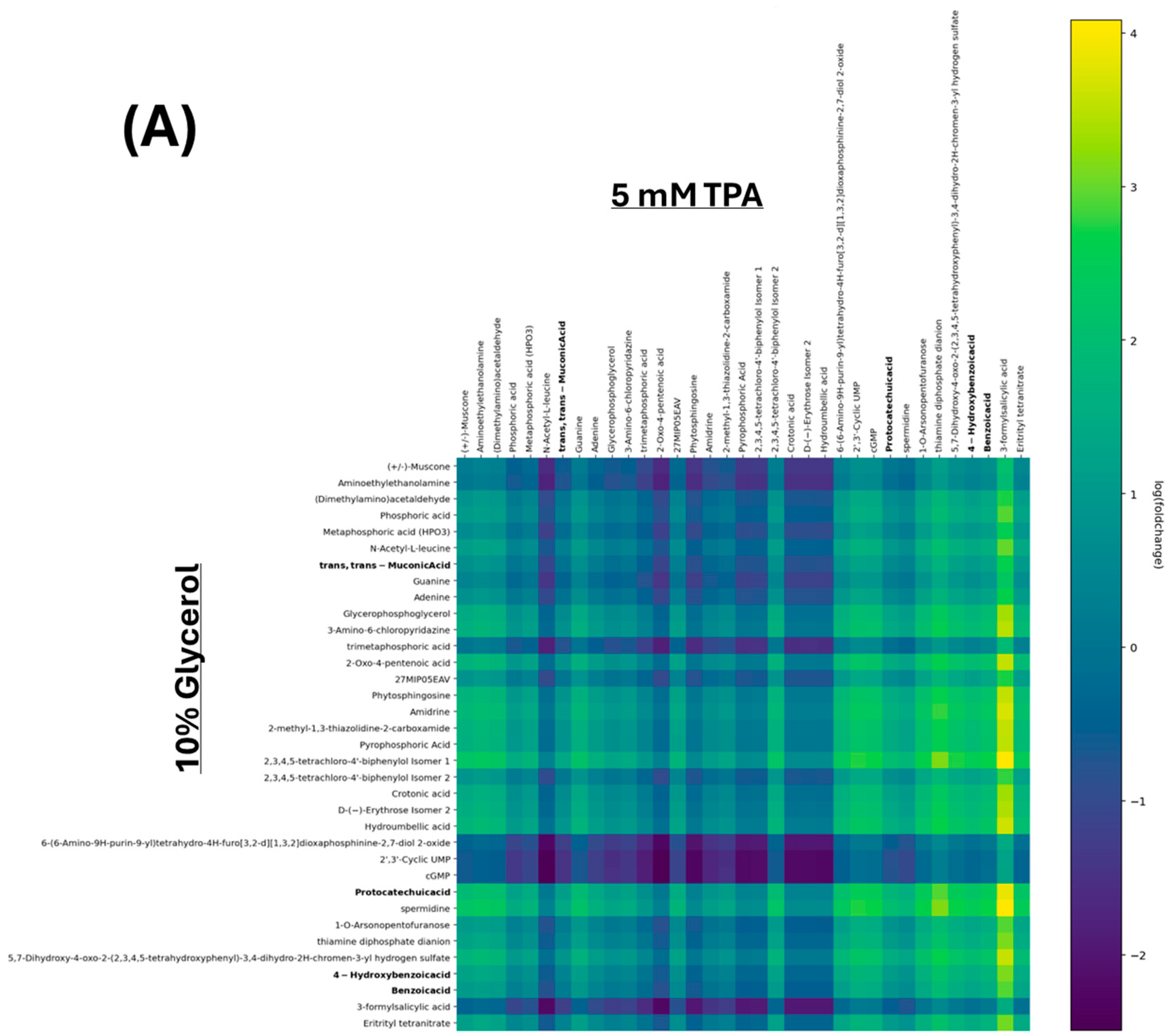

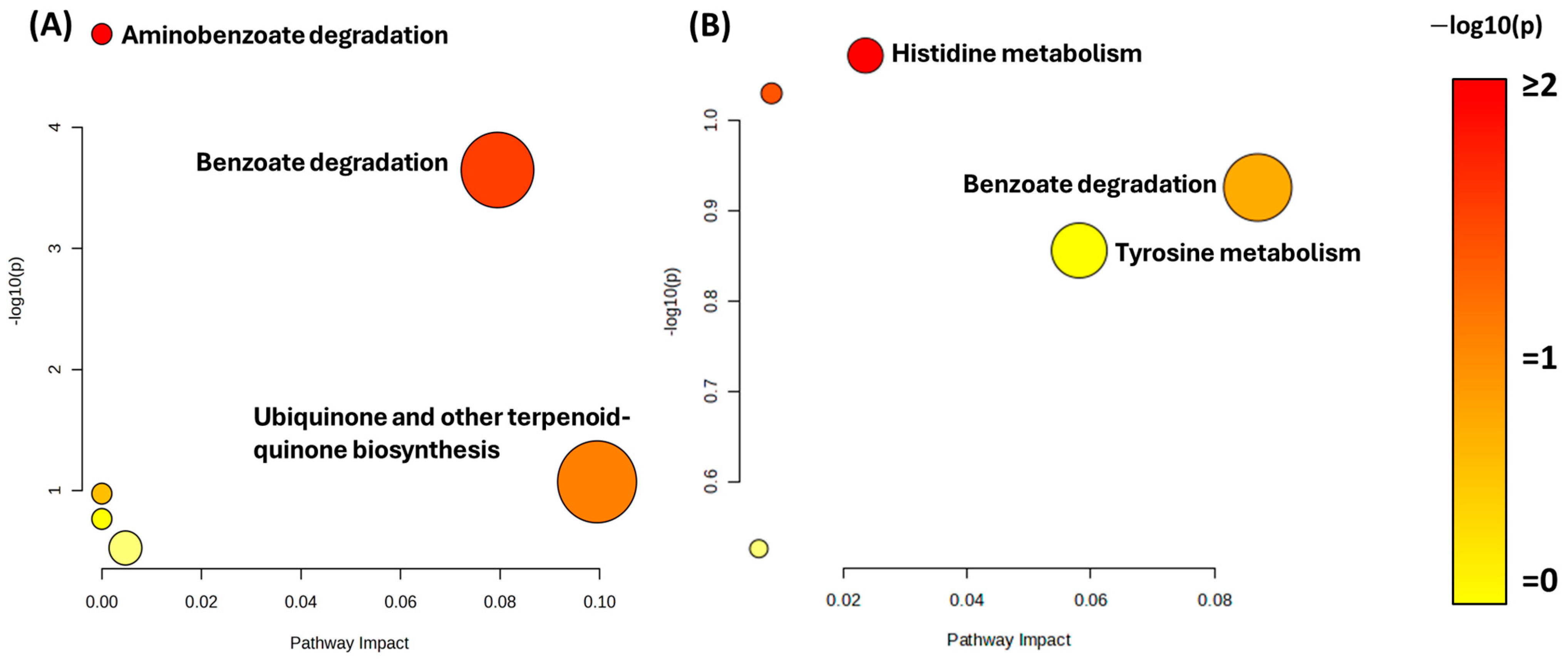

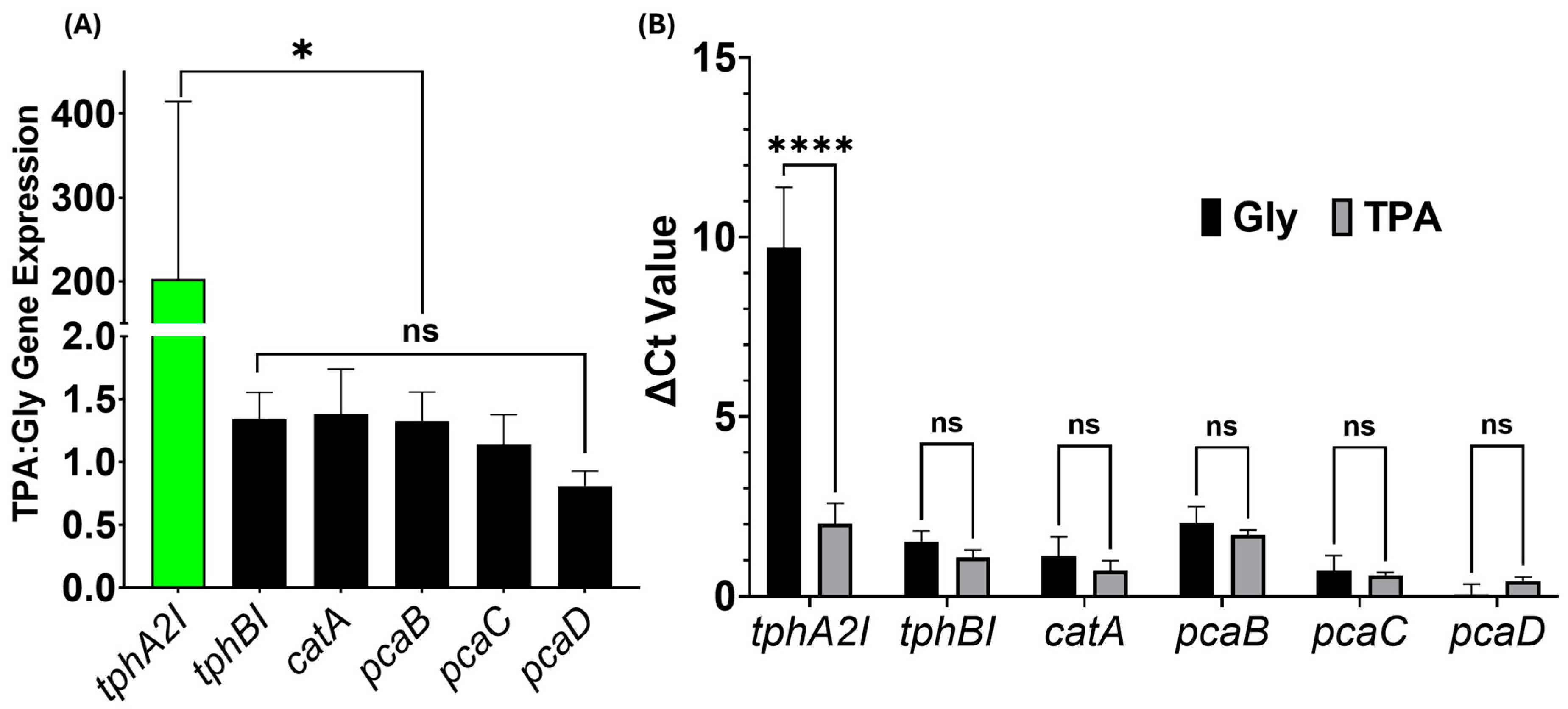
Disclaimer/Publisher’s Note: The statements, opinions and data contained in all publications are solely those of the individual author(s) and contributor(s) and not of MDPI and/or the editor(s). MDPI and/or the editor(s) disclaim responsibility for any injury to people or property resulting from any ideas, methods, instructions or products referred to in the content. |
© 2025 by the authors. Licensee MDPI, Basel, Switzerland. This article is an open access article distributed under the terms and conditions of the Creative Commons Attribution (CC BY) license (https://creativecommons.org/licenses/by/4.0/).
Share and Cite
Slobodian, M.R.; Jillings, D.; Barot, A.K.; Dougherty, J.; Passi, K.; Tharmalingam, S.; Appanna, V.D. Metabolism of Terephthalic Acid by a Novel Bacterial Consortium Produces Valuable By-Products. Microorganisms 2025, 13, 2082. https://doi.org/10.3390/microorganisms13092082
Slobodian MR, Jillings D, Barot AK, Dougherty J, Passi K, Tharmalingam S, Appanna VD. Metabolism of Terephthalic Acid by a Novel Bacterial Consortium Produces Valuable By-Products. Microorganisms. 2025; 13(9):2082. https://doi.org/10.3390/microorganisms13092082
Chicago/Turabian StyleSlobodian, Mitchell Read, Dominique Jillings, Aditya Kishor Barot, Jessica Dougherty, Kalpdrum Passi, Sujeenthar Tharmalingam, and Vasu D. Appanna. 2025. "Metabolism of Terephthalic Acid by a Novel Bacterial Consortium Produces Valuable By-Products" Microorganisms 13, no. 9: 2082. https://doi.org/10.3390/microorganisms13092082
APA StyleSlobodian, M. R., Jillings, D., Barot, A. K., Dougherty, J., Passi, K., Tharmalingam, S., & Appanna, V. D. (2025). Metabolism of Terephthalic Acid by a Novel Bacterial Consortium Produces Valuable By-Products. Microorganisms, 13(9), 2082. https://doi.org/10.3390/microorganisms13092082





